
Kent Physics centre welcomes Prof. Nabil Iqbal from the University of Durham for his talk on "The holographic principle: from black holes to the edge of spacetime".
Kent physics centre welcomed Nabil Iqbal from the University of Durham where he is a professor of theoretical physics. Nabil’s talk received an audience of over 60 attendees.
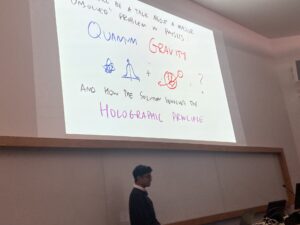
The talk to discussed the small matter of a unified theory of physics; combining both quantum mechanics and gravity. In reality, such a theory is a “holy grail” for physicists, and has proved an almost insurmountable challenge. The problem is that both theories provide excellent, precise descriptions of the universe, but are not compatible with each other.
Quantum mechanics describes the physics of very small things, such as atoms and electrons. Despite the perception in popular culture, quantum theory is very well understood (although there are some philosophical questions that remain). A key result from quantum theory is that measurements always contain an intrinsic uncertainty, leading to inherent fluctuations. Even with this uncertainty, the predictions made by quantum mechanics are in excellent agreement with experimental observations. Indeed, this understanding has lead to technological revolutions; the transistor, MRI machines, and superconductors to name a few.
Our best understanding of gravity is Einstein’s theory of Relativity, describing the behaviour of large, heavy things, such as planets, stars, and black holes. Like quantum mechanics, Relativity is also a very well understood theory, and makes a wealth of accurate predictions. Two famous examples are the detection of gravitational waves, and the “observation” of a black hole. The essential point to understand is that gravity is a curvature of space and time which keeps the Earth in orbit around the Sun, and the Sun around the black hole at the centre of the galaxy.
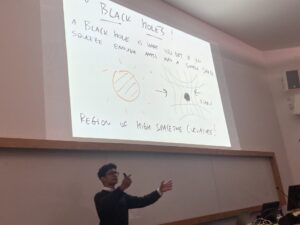
It would seem natural that there is some way to connect these two theories, seeing as both make predictions that agree with our observations of the universe. However, the fluctuating, uncertain nature of quantum mechanics is quite incompatible with relativity. In order to start reconciling this incompatibility, a discussion of entropy becomes necessary.
Entropy is essentially a number that quantifies how much we don’t know about a system. For example, we can imagine a dice in a sealed box. There are 6 possible sides that could be face up when we open the box; a value of 6 can be ascribed to the entropy of the dice. Another example might be to consider two books of different lengths. In this case, the entropy of the longer book is larger than that of the small book; intuitively, there is more that we do not know about the larger book. To be slightly more mathematical, the entropy can be seen to grow with the volume of the book.
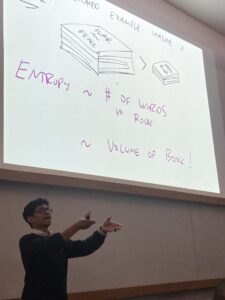
Now, what is most peculiar is the entropy of a black hole. In the 1970s, Jacob Bekenstein, and later Stephen Hawking, showed that the entropy of a black hole scales as the area of its event horizon (the point past which nothing can escape)! To contextualise how strange this is, this would be the same as entropy scaling with just the cover of the aforementioned books!
The equation derived for the entropy is really quite beautiful, containing fundamental constants that encapsulate all of physics; hot (Boltzmann’s constant), fast (the speed of light), heavy (the Gravitational constant), and small (Planck’s constant).
We are aware that volume is inherently a three dimensional quantity, while area is two dimensional. This relation was applied to the issue of connecting quantum mechanics and relativity in 1997 by Maldacena who postulated that volume (and three dimensional space) is a holographic projection of the entropy (information) on the area of its boundary. Thus, the titular holographic principle.
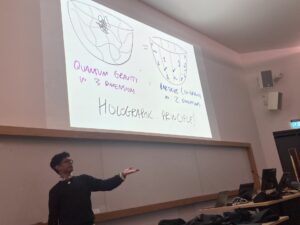
Whilst this principle provides excellent insights about what could constitute a unified theory of quantum mechanics and gravity, there is a notable caveat to be aware of. The holographic principle is formulated in terms of “anti-de Sitter space”. The best model we have for the universe seems to indicate a de Sitter space, which is in contrast to that needed for the holographic principle.
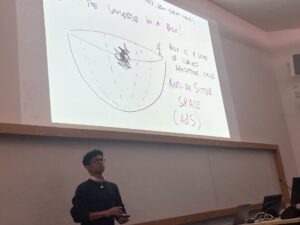
Nevertheless, the talk was fascinating and Professor Iqbal explained the complex topics of quantum mechanics and relativity in an approachable and intuitive way.
Join us on March 18th for a talk from Professor Richard Blythe (University of Edinburgh) who will discuss “The physics behind our irreversible reality”. Details can be found here.